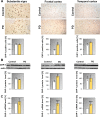HSP90 and Its Novel Co-Chaperones, SGT1 and CHP-1, in Brain of Patients with Parkinson's Disease and Dementia with Lewy Bodies
- PMID: 30741686
- PMCID: PMC6398563
- DOI: 10.3233/JPD-181443
HSP90 and Its Novel Co-Chaperones, SGT1 and CHP-1, in Brain of Patients with Parkinson's Disease and Dementia with Lewy Bodies
Abstract
Background: Parkinson's disease (PD) is a neurodegenerative disorder characterized by the presence of inclusions known as Lewy bodies in some brain regions. Lewy bodies consist of α-synuclein and many other proteins including chaperones.
Objective: To learn more about the role of chaperone complexes in PD and a related disorder, i.e., dementia with Lewy bodies (DLB), in this work we analyzed the expression of HSP90 and its two quite recently identified co-chaperones, SGT1 and CHP-1, in selected brain regions from patients suffering from these diseases.
Methods: To fulfill the aim of our study we used human material and applied immunohistochemistry, Western blot analysis and real time/quantitative PCR (RT-qPCR).
Results: We have found that HSP90 mRNA level is higher in the temporal cortex of PD and in frontal cortex of DLB brains, even though level of protein does not change significantly. The mRNA level of SGT1 is higher in the frontal and temporal cortex of PD and in substantia nigra of DLB brains while no significant changes in the level of protein were noticed. Similarly, the mRNA level of CHP-1 was found to be higher in the frontal and temporal cortex of PD and in all examined regions i.e. substantia nigra, frontal and temporal cortex of DLB brains. In the case of CHP-1 the protein level was found to be higher in frontal cortex of PD and in all examined areas of DLB patients.
Conclusions: Our data indicate that the level of HSP90, SGT1 and CHP-1 is upregulated in the majority of cases of PD and DLB, which suggests that the examined proteins might be involved in these pathologies.
Keywords: CHP-1; HSP90; Parkinson’s disease; SGT1; dementia with Lewy bodies.
Conflict of interest statement
The authors have no conflict of interest to report.
Figures




References
Publication types
MeSH terms
Substances
LinkOut - more resources
Full Text Sources
Medical

